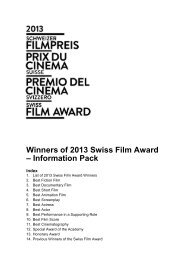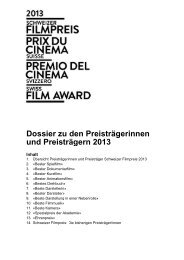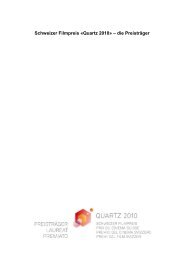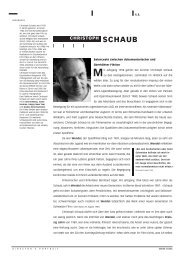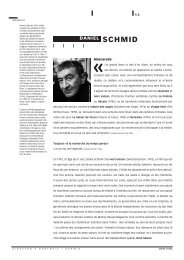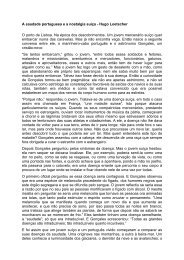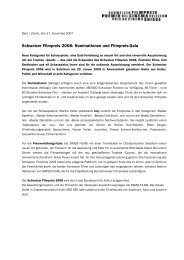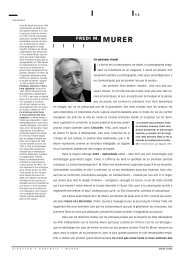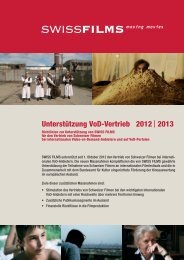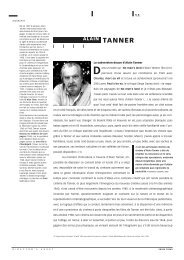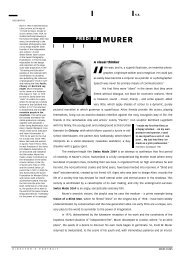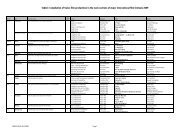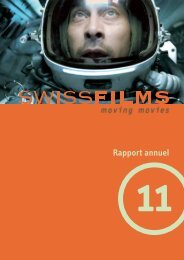Director's Portrait Alain Tanner - Swiss Films
Director's Portrait Alain Tanner - Swiss Films
Director's Portrait Alain Tanner - Swiss Films
Create successful ePaper yourself
Turn your PDF publications into a flip-book with our unique Google optimized e-Paper software.
BIOGRAPHY<br />
Born in Geneva in 1929, <strong>Alain</strong><br />
<strong>Tanner</strong> studied socio-economics.<br />
At the age of 23 he enlisted<br />
in the merchant navy and was<br />
mustered by the West Africa<br />
Line in the port of Genoa. After<br />
this very formative experience<br />
on the high seas, he returned<br />
briefly to Switzerland, then set<br />
off for London, where he lived<br />
from 1955 to 1958. It was here<br />
that he fell in love with the cinema,<br />
frequenting the Cinémathèque<br />
and making friends with<br />
critics and members of the<br />
British “Free Cinema” movement,<br />
such as Lindsay Anderson<br />
and Karel Reisz. With them<br />
he shared an interest in the<br />
critical and political dimension<br />
of the cinema, inspired largely<br />
by Bertolt Brecht. In 1957, he<br />
made his first film in London<br />
with his friend Claude Goretta.<br />
This 16-mm short, entitled Nice<br />
Time, featured the night life of<br />
the Piccadilly district. In 1960,<br />
<strong>Alain</strong> <strong>Tanner</strong> returned permanently<br />
to Switzerland, where he<br />
was commissioned to make a<br />
number of documentaries in<br />
the cinéma vérité style of the<br />
time. This was the beginning of<br />
a long period of collaboration<br />
with <strong>Swiss</strong> television. From<br />
1965 to 1968, <strong>Tanner</strong> made<br />
films on a wide range of subjects,<br />
including Docteur B,<br />
médecin de campagne (1968),<br />
on the daily life of a doctor in<br />
the <strong>Swiss</strong> countryside, and Une<br />
ville à Chandigarh (1966), on<br />
the work of the architect Le<br />
Corbusier in India. <strong>Tanner</strong>’s<br />
work for <strong>Swiss</strong> television came<br />
to an end in 1968, when he<br />
embarked on his career as an<br />
independent director. In that<br />
year, he founded Groupe 5 in<br />
conjunction with four other<br />
<strong>Swiss</strong> film-makers: Claude<br />
Goretta, Michel Soutter, Jean-<br />
Louis Roy and Jean-Jacques<br />
Lagrange. Since 1969, <strong>Alain</strong><br />
<strong>Tanner</strong> has made 20 full-length<br />
films, the most recent being<br />
Paul s’en va (2004).<br />
D I R E C T O R ’ S S H E E T<br />
ALAIN TANNER<br />
The subtle subversion of <strong>Alain</strong> <strong>Tanner</strong><br />
n an article on <strong>Alain</strong> <strong>Tanner</strong>’s No Man’s Land, a film made at<br />
the mid-point of a career which began in 1969 with Charles<br />
Dead or Alive and reached its (provisional?) conclusion in 2004<br />
with Paul s’en va, the critic Serge Daney wrote: “I looked at the<br />
landscapes of No Man’s Land and was not disorientated. I felt<br />
at home. I had seen it all before in an earlier life punctuated by<br />
the nine other films of <strong>Alain</strong> <strong>Tanner</strong> (…) I even knew what it con-<br />
sisted of: frontier posts with a French and a <strong>Swiss</strong> side, slow-<br />
moving bicycles and tidy little cafés, ruminating cows and drawling accents, roads into the moun-<br />
tains and paths leading nowhere; I knew the characters, too, having seen them come and go: they<br />
were flawed and bad in ’68, then armchair idealists, then, in ’85, embittered, dissatisfied hippies,<br />
that’s all.” Then, having expressed his deep sense of familiarity with the world of the film, the crit-<br />
ic voices a doubt: “It struck me that all the things that – thanks to <strong>Tanner</strong> and other <strong>Swiss</strong> film-<br />
makers (Reusser, Soutter, Murer) – I had come to see as familiar, all this mildly clean, mildly sinis-<br />
ter, mildly beautiful <strong>Swiss</strong> cinema, with its cows and its traffickers, its calculated slowness and<br />
vague storytelling, might be on the way out.” (1).<br />
In introducing the work of <strong>Alain</strong> <strong>Tanner</strong>, it is impossible<br />
to ignore this bitter but lucid comment from twenty years ago,<br />
impossible to grasp the meaning of his work except through<br />
an act of retrospection, looking back and realising that the<br />
body of ideas and the creative context which opened the way<br />
for the films of <strong>Alain</strong> <strong>Tanner</strong> – and indeed the emergence of the new <strong>Swiss</strong> cinema at the end of<br />
the 1960s – have been gradually buried since the 1980s. The cinematographic modernity embo-<br />
died by <strong>Tanner</strong>, a tough and constant questioning of the nature and status of representation in<br />
film, has been superseded by the age of visual promiscuity and ad-industry rhetoric – with the<br />
inevitable effects. The result has been the slow but sure disappearance of the cinematographic<br />
memory and awareness which gave birth to <strong>Tanner</strong>’s films.<br />
I<br />
“One of the principal merits of<br />
<strong>Alain</strong> <strong>Tanner</strong>’s cinematographic<br />
work is no doubt that – in a<br />
nation drowsed by a facile ideology<br />
of neutrality – he has aroused<br />
and stimulated the dormant<br />
critical faculties and spirit of his<br />
audience.” Domenico Lucchini, 2002<br />
From the 1980s, his films are increasingly influenced by a sense of loss and extinction. He<br />
is compelled to respond by concentrating on essentials, moving away from the discourse deriving<br />
from 1968 and striking out for more physical territory, exploring a sensual side of his creativity<br />
which, though it still says a great deal about the world, is concerned above all with recording it in<br />
1.1.<br />
(1) Serge Daney, Libération, 30 August 1985, quoted in Ciné-journal, volume 2, Petite bibliothèque des Cahiers du cinéma, Paris, 1998.<br />
SWISS FILMS
FILMOGRAPHY<br />
1957 Nice Time<br />
1961 Ramuz, passage d’un poète<br />
1962 The School<br />
1964 Les apprentis<br />
1966 A City at Chandigarh<br />
1969 Charles, mort ou vif<br />
1971 La salamandre<br />
1973 Le retour d’Afrique<br />
1974 Le Milieu du Monde<br />
1976 Jonas qui aura vingt-cinq ans<br />
en l’an 2000<br />
1977 Foot-Ball<br />
Dead Time<br />
1978 Messidor<br />
1981 Light Years Away<br />
1983 Dans la ville blanche<br />
1985 No Man’s Land<br />
1987 Une flamme dans mon cœur<br />
La vallée fantôme<br />
1989 La femme de Rose Hill<br />
1991 L’homme qui a perdu son<br />
ombre<br />
1992 Le journal de Lady M.<br />
1995 Les hommes du port<br />
Fourbi<br />
1998 Requiem<br />
1999 Jonas et Lila, à demain<br />
2002 Fleurs de sang (co-directeur)<br />
2004 Paul s’en va<br />
D I R E C T O R ’ S S H E E T<br />
ALAIN<br />
> The subtle subversion of <strong>Alain</strong> <strong>Tanner</strong><br />
TANNER<br />
its starkness. So we have Bruno Ganz’s wanderings in Lisbon in In the White City (1982), the<br />
fragile, feral body of Myriam Mézières in A Flame in My Heart or The Diary of Lady M… It is<br />
therefore legitimate to note a progression from the political to the poetic – the two are never<br />
mutually exclusive in <strong>Tanner</strong>’s work – and to make something of a distinction between the films<br />
that came out of 1968, with their concern for utopian illusions and disappointments – Charles<br />
Dead or Alive, The Salamander, Return from Africa, The Middle of the World, Messidor and<br />
of course Jonas Who Will Be 25… – and those that seem to have left that legacy behind: Light<br />
Years Away, In the White City, A Flame in My Heart.<br />
Then there is a final period, reflecting <strong>Tanner</strong>’s collaboration with the writer Bernard Com-<br />
ment. The resulting “trilogy” – Fourbi, Jonah and Lila, till<br />
tomorrow and Paul s’en va – is both ambitious and muddled.<br />
These films reflect a renewed belief in the world, his experi-<br />
ences and the thinking which makes sense of it, almost a<br />
return to earlier years. In these three films, the enemy is more<br />
clearly identified and a strong desire expressed with a kind of<br />
gentle rage: to break free of the sad age in which we live, armed with poetry and sensitive to the<br />
beauty of the world. “If all I can do is speak, it is for you I will speak”: this quotation from Aimé<br />
Césaire echoes through Paul s’en va as it did in Return from Africa, reconnecting with the past,<br />
re-establishing the cyclical, tribal sense of time so dear to <strong>Tanner</strong>, which stands in opposition to<br />
the “capitalist motorway of progress”. Poetics and politics combined.<br />
The name of <strong>Alain</strong> <strong>Tanner</strong> is inextricably linked with a particular historical moment. Polit-<br />
ically, post-1968 is the space-time frame in which his films are set. Artistically, his work corres-<br />
ponds to the emergence, in the period 1965–1975, of the “new cinema” movements, which<br />
brought forth such notable film-makers as Glauber Rocha, Miklós Jancsó, Jerzy Skolimowski, Marco<br />
Bellochio and <strong>Alain</strong> <strong>Tanner</strong> himself. The common factor linking these directors, despite their widely<br />
differing styles and approaches, is that they build on the lessons taught by the “great modernists”<br />
of the post-war era (Rossellini, Bresson) – not to engage in a parodied form of post-modernity,<br />
which is now the dominant trend, but to work out connections between the language these great<br />
directors invented and the new world emerging in this post-post-war period. However, unlike the<br />
other directors mentioned, each of whom invented an imaginary world strongly influenced by<br />
their country of origin (the culturally mixed Brazil of Rocha, the highly politicised Hungary of Jancsó,<br />
the Italy of Bellochio…), in his films <strong>Alain</strong> <strong>Tanner</strong> created a world built on a defective foundation:<br />
Switzerland. The director once expressed the regret that, unlike the Taviani brothers on their<br />
travels, he could not take along a little of his native soil on his shoes. Switzerland as a non-place,<br />
1.2.<br />
“It takes cosmopolitan cities<br />
and deserts to the give new life<br />
to the film genre. I am imbued<br />
by place, and I don’t mean stage<br />
settings, but place itself, the<br />
eroticism of landscape. I didn’t<br />
invent this term, but it fits me.”<br />
<strong>Alain</strong> <strong>Tanner</strong>, 1996<br />
SWISS FILMS
PRIZES<br />
1957 Nice Time, Best Experimental<br />
Film, in the category Short<br />
Film, Venice International Film<br />
Festival and Locarno Film<br />
Festival<br />
1968 Docteur B., Médécin de<br />
Campagne, <strong>Swiss</strong> TV Prize<br />
1971 La Salamandre, Oscar<br />
nomination for Best Foreign<br />
Film (<strong>Swiss</strong> entry)<br />
1973 Le retour d’Afrique,<br />
International Film Festival<br />
Berlin, Ecumenical Jury Prize<br />
1976 Jonas, qui aura vingt-cinq<br />
ans en l’an 2000, Locarno<br />
International Film Festival,<br />
Critics’ Prize; American Critics’<br />
Prize for Best Script, New York<br />
1976<br />
1978 Messidor, Festival of Lima<br />
1980, Lama d’Or<br />
1981 Les années lumières,<br />
Cannes International Film<br />
Festival, Special Jury Prize<br />
1983 Dans la ville blanche,<br />
César (Best French-Language<br />
Film) 1983; Official Selection<br />
1985 No Man’s Land, Official Selection<br />
in Competition, Venice<br />
International Film Festival<br />
1986 Une flamme dans mon cœur,<br />
Houston International Film<br />
Festival 1988, Special Jury Prize<br />
1987 La vallée fantome, Official<br />
Selection in Competition, Venice<br />
International Film Festival<br />
1989 La femme de Rose Hill,<br />
Official Selection in Competition,<br />
Venice International Film<br />
Festival<br />
1995 Fourbi, Official Selection in<br />
“Un Certain Regard”, Cannes<br />
International Film Festival<br />
1997 Requiem, Selection for “30th<br />
Directors’ Fortnight”, Cannes<br />
International Film Festival 1998<br />
1999 Jonas et Lila, à demain,<br />
Official Selection,<br />
San Sebastian Film Festival<br />
D I R E C T O R ’ S S H E E T<br />
ALAIN<br />
> The subtle subversion of <strong>Alain</strong> <strong>Tanner</strong><br />
a land “without history”, fatally neutral, the country of the “cuckoo clock” made fun of in The<br />
Third Man, is the ever-present/absent figure in <strong>Tanner</strong>’s cinema, the stateless state which sup-<br />
plies the poetic nourishment for each of his films. And this no-man’s-land status and lack of<br />
national character call forth their opposite: the Utopia (etymologically: no place) of which <strong>Tanner</strong><br />
draws a tender and accurate map.<br />
Ultimately, the characters in <strong>Tanner</strong>’s films always have three questions in mind, concern-<br />
ing a) their desires and b) the space in which they are to deploy them – Utopia being the term<br />
expressing the possibility of reconciliation between the two when “terra firma” (society, family,<br />
homeland) gives up on them. The first question – to whom or what am I attached? – is the ques-<br />
tion of desire. There are various responses: abandon one’s bourgeois comfort (Charles Dead or<br />
Alive), quit one’s job and take to the streets (The Salamander), run away and gamble everything<br />
(Messidor), get on a ship and go into exile (In the White City).<br />
This desire, which runs throughout <strong>Tanner</strong>’s fiction, is stubborn<br />
and tenacious. Like that of the tick, an insect taken from the<br />
Deleuzian bestiary (no coincidence!), which Roger Jendly (the peasant farmer) praises in Jonah<br />
Who Will Be 25 in the Year 2000: to survive, the tick needs only light, a tuft of hair and an<br />
extremity. A model of obstinate thrift.<br />
The second question refers back to and depends on the first: to whom or what do I<br />
belong? This is the issue of territory, of defining boundaries: “My territory extends as far as I can<br />
see,” says someone in Jonah… And often, we go off and look elsewhere. The distance and tra-<br />
jectory travelled fix the frontiers of the desire revealed in movement. Finally, the third question is<br />
practically an affirmation, a lucid impulse suggesting the pessimism of his work. It is a doubt (felt<br />
by the director, or the character himself) that undermines the enterprise of liberation, of escape<br />
from the person’s territory. <strong>Tanner</strong> is one of those directors who is never satisfied with the mere<br />
appearance of truth. The indecisiveness of his characters is part of the genetic make-up of his<br />
cinema. In A Flame in My Heart, Pierre and Mercedes are on the balcony of their Cairo hotel.<br />
Fullness of joy, desire fulfilled, far from the grey grind of daily life? “With no clothes on, it is<br />
impossible to think,” he says, looking at her. “It was Rodin who said that,” she replies. Why, at this<br />
precise moment, does Pierre think about thinking? Here lies the doubt that eventually pushes<br />
Mercedes to run away and leads to her sublime plan of ultimate solitude.<br />
Roland Barthes preferred the word “subversion” to “revolution” because – he said – the<br />
former is a “clearer word” denoting an “underhand way of cheating on things, turning them aside,<br />
taking them somewhere other than the place expected”. Subversion as a way of shifting things,<br />
1.3.<br />
TANNER<br />
“I never considered making<br />
films as work. It was never a<br />
conscious effort, it was always<br />
fun.”<strong>Alain</strong> <strong>Tanner</strong>, 1996<br />
SWISS FILMS
FILMS ABOUT ALAIN TANNER<br />
1978 Cinema Mort ou Vif?<br />
Cinema Dead or Alive? Directed<br />
by: Urs Graf, Mathias Knauer,<br />
Hans Stürm. Produced by:<br />
Filmkollektiv Zürich. 16mm,<br />
colour, 105’<br />
1981 <strong>Tanner</strong> tourne Light Years<br />
Away, <strong>Tanner</strong>’s Making of Light<br />
Years Away. Directed by:<br />
Francis Reusser. Produced by:<br />
SSR.16mm, colour, 15’<br />
ESSENTIAL BIBLIOGRAPHY<br />
1974 Freddy Buache, Le cinema<br />
Suisse, L’Age d’homme,<br />
Lausanne, pp. 139–159,<br />
publication completed in 1978<br />
1984 Jim Leach, A Possible Cinema:<br />
the <strong>Films</strong> of <strong>Alain</strong> <strong>Tanner</strong>, The<br />
Scarecrow Press Inc., Metuchen,<br />
and London<br />
1985 Christian Dimitriu, <strong>Alain</strong> <strong>Tanner</strong>,<br />
Henri Veyrier, Paris<br />
1987 Piera Detassis, <strong>Alain</strong> <strong>Tanner</strong>,<br />
La Nouva Italia, Il castoro<br />
cinema, Florence.<br />
2002 Domenico Lucchini, <strong>Alain</strong><br />
<strong>Tanner</strong>, Tra realismo et utopia,<br />
Centro Culturale Svizzero and<br />
Editrice Il Castoro, Milan<br />
ABOUT THE AUTHOR<br />
Frédéric Bas is a lecturer and a<br />
cinema critic for the Chronicart<br />
website and magazine.<br />
He lives in Paris and is currently<br />
writing a book on the films<br />
of <strong>Alain</strong> <strong>Tanner</strong>.<br />
D I R E C T O R ’ S S H E E T<br />
ALAIN<br />
> The subtle subversion of <strong>Alain</strong> <strong>Tanner</strong><br />
of imposing a deviation on the straight line, a subtle engine of war against the commonplace, is a<br />
possible key to the cinema of <strong>Alain</strong> <strong>Tanner</strong>. Taking into account the poetic and the political, it<br />
explains an approach which never tries too hard to grab the spectator’s attention, but is careful<br />
to allow him some space, which “plays” with his expectations and avoids overwhelming him visu-<br />
ally. Cultivating this visual vigilance so as not to err on the side of the panoramic, shattering the<br />
mirror effect of the screen, has always been <strong>Tanner</strong>’s concern, his primary subversion on the aes-<br />
thetic level. In the years after 1968, this was known as “the work of the spectator”. At the time,<br />
making the camera movements obvious (the famous right-to-left shots in Return from Africa) or<br />
accentuating the diction of the actors was a way of subverting the transparency of the grand Hol-<br />
lywood manner so as to reconnect with the spectator and at last give him a place: the physical<br />
place from which he observes in the darkened auditorium, when he is alone facing the screen;<br />
not the “ticket place” sold at the box-office, when he is lost in the waiting queue. Nowadays,<br />
there is no such distinction. In his diary, the critic Serge Daney (again!) wrote that the “author’s<br />
policy” should be matched by a “spectator’s policy”. Of the former, he said that it was not only<br />
“the recognition of a director’s artistic autonomy”, but also “the possibility of transfer (and there-<br />
fore of love) between two people who use the film (whether already made or to be made) to get<br />
their bearings in the world, to find their place there”. More than any other, <strong>Tanner</strong>’s cinema<br />
enables us to feel our way to this place. Frédéric Bas, 2004<br />
1.4.<br />
TANNER<br />
SWISS FILMS
Script: <strong>Alain</strong> <strong>Tanner</strong><br />
Camera: Renato Berta<br />
Sound: Paul Girard<br />
Editing: Sylvia Bachmann<br />
Music: Jacques Olivier<br />
Cast: François Simon, Marcel Robert,<br />
Marie-Claire Dufour, André Schmidt,<br />
Maya Simon, Michèle Martel<br />
and others<br />
harles Dead or Alive, <strong>Alain</strong> <strong>Tanner</strong>’s first feature film, which won the Grand Prix at the<br />
Locarno Festival in 1969, is the kind of manifesto that, with other films such as La lune avec les<br />
dents and Haschich by Michel Soutter, put Switzerland on the world cinema map at the end of the<br />
1960s. That the critics baptised the wave which emerged at this time as the “new <strong>Swiss</strong> cinema”<br />
simply reflects the fact that the “old” <strong>Swiss</strong> cinema was unknown to the cinema-going public. Today,<br />
the appeal and energy of this first film remain undiminished, magnified by the exceptional stature<br />
and presence of François Simon and the sublimely uncluttered camera work of Renato Berta. <strong>Tanner</strong><br />
drew his subject matter from what he saw of the events of May ’68 in Paris, which he covered for<br />
<strong>Swiss</strong> television. Unimpressed by the ideological pronouncements of the young demonstrators (<strong>Tanner</strong><br />
was nearly 40 and mistrustful of the siren songs of militancy), he was more struck by the elderly<br />
people marching alongside them. The film therefore paints the portrait of an old man who decides to<br />
abandon his comfortable bourgeois way of life and live with a bohemian couple. There he redis-<br />
covers his freedom to think and his joie de vivre. As Mireille Amiel points out in Cinéma 70:“Charles<br />
Dead or Alive, which the author himself defines as a ‘small-scale historical fresco’ is a good<br />
example of the best of political cinema in our developed Western societies.” It is also worth adding<br />
another, definitive judgement, pronounced by Jean-Louis Bory in Le Nouvel Observateur: “It is the<br />
most intelligent film inspired by the spirit of May ‘68.” Frédéric Bas<br />
CHARLES DEAD OR ALIVE<br />
1969 16/35mm b/w 94’ b/w Charles mort ou vif<br />
C<br />
F E A T U R E F I L M S / T A N N E R<br />
Production: <strong>Alain</strong> <strong>Tanner</strong> and the<br />
Groupe Cinq<br />
World Rights: <strong>Alain</strong> <strong>Tanner</strong><br />
Original Version: French<br />
SWISS FILMS
Script: <strong>Alain</strong> <strong>Tanner</strong> and John Berger<br />
Camera: Renato Berta<br />
Sound: Marcel Sommerer, Gerard<br />
Rhône<br />
Editing: Brigitte Sousselier, Marc<br />
Blavet<br />
Music: Patrick Moraz and the Main<br />
Horse Airline Group<br />
1971 16/35mm b/w 128’ La Salamandre<br />
T<br />
he Salamander brought <strong>Alain</strong> <strong>Tanner</strong> acclaim and his first public triumph. Presented at the<br />
Cannes Film Festival in the “Quinzaine des réalisateurs” section in 1971, the film made the<br />
world aware of the abrasive tone and energy of the new <strong>Swiss</strong> cinema, with <strong>Tanner</strong> as its em-<br />
blematic director. The scenario derives from <strong>Tanner</strong>’s experience as a journalist/reporter for<br />
<strong>Swiss</strong> television between 1965 and 1968. The Salamander begins with a succession of enigmatic<br />
images of the kind very much favoured by today’s TV reconstructions: a man is shown cleaning<br />
his gun; the gun goes off; furtively, a woman’s face appears. What is happening? On this mysterious<br />
opening, which serves as a pretext, <strong>Tanner</strong> builds a metaphorical scenario: two men, a journalist<br />
and a writer, throw themselves into the investigation to find out the truth about this woman. Each<br />
uses his own weapons: documentary research in one case, boundless imagination in the other.<br />
But gradually, both courses of action prove futile. As it turns out, the encounter with their subject,<br />
Rosemonde, ruins their studied efforts to discover the truth, and the emergence of a trio of free,<br />
critical individuals supersedes the cold, laborious exercise in truth-seeking. The beauty of the film<br />
lies in its capacity to make sense without ever hammering the message: reality outruns all efforts<br />
to grasp it, the thesis of all modern cinema since Citizen Kane, to which The Salamander is a<br />
kind of <strong>Swiss</strong> response. Played by Bulle Ogier, Rosemonde is still a definitive incarnation of post-<br />
1968 freedom. Frédéric Bas<br />
F E A T U R E F I L M S / T A N N E R<br />
Cast: Bulle Ogier, Jean-Luc Bideau,<br />
Jacques Denis<br />
Production: <strong>Alain</strong> <strong>Tanner</strong> in association<br />
with Gabriel Auer for SvoCiné<br />
(Geneva)<br />
World Rights: <strong>Alain</strong> <strong>Tanner</strong><br />
Original Version: French<br />
THE SALAMANDER<br />
SWISS FILMS
Script: <strong>Alain</strong> <strong>Tanner</strong><br />
Camera: Renato Berta<br />
Sound: Marcel Sommerer<br />
Editing: Brigitte Sousselier<br />
Music: J.S. Bach, arranged by Arié<br />
Dzierlatka. Interpreted by: François<br />
Marthouret, Josée Destoop, Juliet<br />
Berto, Anne Wiazemski, Pierre Holdener<br />
n ode to liberated speech and to the power of words, “those one speaks to others, those<br />
one speaks in silence”, <strong>Alain</strong> <strong>Tanner</strong>’s third film is inspired by a poet and a poetic text which<br />
deeply affected him as a young director: Cahier d’un retour au pays natal, written in 1939 by Aimé<br />
Césaire. A poem extolled by the Surrealists, this seminal flow of anti-colonial thinking by the West-<br />
Indian-born poet is the bubbling spring which inspires the gestures and words of the film’s main<br />
character, Vincent (François Marthouret), a 30-year-old from Geneva. Weighed down by the monot-<br />
ony and boredom of his life as a well-off westerner, he sells all his possessions and decides to<br />
leave for Algeria with his fiancée. The subject is clearly that of escape from one’s place of belong-<br />
ing, a Rimbaudesque theme dear to <strong>Tanner</strong>, which is here directly linked to the Third Worldist dis-<br />
course of the 1960s and 1970s. But the strength of the film lies in the way it turns this thinking on<br />
its head: on the eve of their departure, chance circumstances prevent the couple from leaving.<br />
Instead, they decide to pursue their dream of escape by living hidden away in their empty apart-<br />
ment. Again, <strong>Tanner</strong> shows that it is the inner mileage travelled that matters, not the arrival at a<br />
destination; the posing of a question rather than the answer. As the director says at the beginning<br />
of the film: “Speaking words can be an act in itself, it can also be a substitute for action.” This is an<br />
important precept for the understanding of <strong>Tanner</strong>’s cinema: poetry is a form of action, and having<br />
it in mind, reciting it, can help to give a new shape to reality: in the film’s final scene, the couple<br />
decide to have a child. Frédéric Bas<br />
RETURN FROM AFRICA<br />
1973 16/35mm b/w 113’ Le retour d’Afrique<br />
A<br />
F E A T U R E F I L M S / T A N N E R<br />
Cast: Josée Destoop, François Marthouret,<br />
Juliet Berto, Anne Wiazemsky,<br />
François Roulet and others<br />
Production: <strong>Alain</strong> <strong>Tanner</strong>, Groupe Cinq<br />
World Rights: <strong>Alain</strong> <strong>Tanner</strong><br />
Original Version: French<br />
SWISS FILMS
Script: <strong>Alain</strong> <strong>Tanner</strong>, John Berger<br />
Camera: Renato Berta<br />
Sound: Pierre Gamet<br />
Editing: Brigitte Sousselier<br />
THE MIDDLE OF THE WORLD<br />
1974 35mm colour 120’ Le milieu du monde<br />
L<br />
F E A T U R E F I L M S / T A N N E R<br />
Music: Patrick Moraz<br />
Cast: Olimpia Carlisi, Philippe Léotard<br />
and others<br />
Production: Citel <strong>Films</strong>, Geneva,<br />
Action <strong>Films</strong>, Paris, SSR Geneva<br />
ike Return from Africa, The Middle of the World is a film about couples and the way peo-<br />
ple experienced life in the early 1970s. It is also <strong>Tanner</strong>’s most theoretical work, the film<br />
which most explicitly sets out his attitudes as a director. The previous film integrated content (the<br />
crisis of the contemporary individual) and form (a distancing effect achieved through the words<br />
spoken by the characters and the camera movements accompanying them), whereas The Middle<br />
of the World makes a sharp separation between the story of a difficult love affair and a strict,<br />
sometimes rigid form, which constantly shatters the apparent naturalism of the plot and the film’s<br />
realistic effects. The film begins with a voice-off: “This film was shot in 1974 in a time of normali-<br />
sation”, then “This film tells the story of an Italian café waitress and a middle-world engineer over<br />
a period of 112 days.” The cartoons indicating the dates of the various events (there are many gaps<br />
in the story), Patrick Moraz’s musical interludes, the landscape shots, which are out of kilter with<br />
the order of the seasons and the events of the story: all are signs of an unusual didactic approach<br />
in a work which manages to conceal its demanding intentions behind the form of the film. But this<br />
strong Brechtian flavour is also explained by the political dimension of the film. <strong>Tanner</strong> has proba-<br />
bly never identified the enemy so pointedly as here: shady, male-chauvinist, provincial politicians,<br />
narrow-minded denizens of bistros. In opposition to this social tackiness, which is all-pervasive,<br />
<strong>Tanner</strong> proposes liberation by the cinema and its language: putting a distance between the reality<br />
represented and the spectator enables the latter to exercise his critical consciousness, performing<br />
what contemporary critics defined as “the work of the spectator”. Fréderic Bas<br />
World Rights: Yves Peyrot<br />
Original Version: French<br />
SWISS FILMS
Script: <strong>Alain</strong> <strong>Tanner</strong> and John Berger<br />
Camera: Renato Berta<br />
Sound: Pierre Gamet<br />
Editing: Brigitte Sousselier<br />
Music: Jean-Marie Sénia<br />
Cast: Nicolas, Myriam Mézières, Jean-<br />
Luc Bideau, Myriam Boyer, Rufus,<br />
JONAH WHO WILL BE 25 IN THE YEAR 2000<br />
1976 35mm colour and b/w 110’ Jonas qui aura 25 ans en l’an 2000<br />
T<br />
ogether with The Salamander, Jonah Who Will Be 25 in the Year 2000 is <strong>Alain</strong> <strong>Tanner</strong>’s<br />
best-known film, and the one which has almost permanently fixed his directorial style in the<br />
consciousness of the public: a mixture of seriousness and humour against a backdrop of social<br />
criticism, a sweet-and-sour utopia of characters given over to their thoughts and fantasies in a<br />
world which is not always designed with them in mind. However, this judgement of the film and its<br />
director carries a risk of misunderstanding. As Serge Daney has written in an article which is basic<br />
reading for this film (1) , Jonah Who Will Be 25 in the Year 2000 in no way expresses an unam-<br />
biguous left-wing point of view and does not crystallise the social struggle in the name of com-<br />
radely nostalgia. Although the film records the states of mind and dreams of the 1968 generation<br />
without their violence or hatred, the intention is definitely not to paint a reassuring picture and<br />
turn the militants of yesterday into likeable figures. The aim is to reveal the secret, generally con-<br />
cealed wounds of a series of individuals sufficiently inured to the social order not to engage in<br />
open conflict. The eight characters featured in the film (their names all begin with “Ma…”, possibly<br />
an allusion to “Mao”) fight with their own weapons, which are rarely political but derive from their<br />
childhood, an area of boundless freedom and playfulness which the system cannot tame. This<br />
praise of the indomitably childlike quality of the 1968 generation is one of the morals of the film:<br />
“Jonah… is a didactic film with no lesson to teach, an encyclopaedic film with no conclusion”, a<br />
film of freedom. Fréderic Bas<br />
F E A T U R E F I L M S / T A N N E R<br />
Dominique Labourier, Roger Jendly,<br />
Miou-Miou, Jacques Denis, Raymond<br />
Bussières and others<br />
Production: Citel <strong>Films</strong>, Geneva,<br />
(1): “Les huit Ma”, in Le cinéma et le monde, 1; Le Temps des Cahiers 1962-1981, P.O.L, Paris, 2001, pp. 184-189<br />
Action <strong>Films</strong>, Paris, SFP SSR<br />
World Rights: Yves Peyrot<br />
Original Version: French<br />
SWISS FILMS
Script: <strong>Alain</strong> <strong>Tanner</strong><br />
Camera: Renato Berta<br />
Sound: Pierre Gamey<br />
Editing: Brigitte Sousselier<br />
Music: Arié Dzierlatka<br />
1979 35mm colour 130’<br />
A<br />
project initially entrusted to Maurice Pialat, who had already begun to film it under the title<br />
of “Meurtrières” (see the special edition of Les Inrockuptibles devoted to Pialat), Messidor<br />
is based on a crime story which hit the headlines in France in the 1970s: two adolescent girls run<br />
away and go on a criminal spree which ends in their deaths. On the face of it, this subject is<br />
remote from the world we associate with <strong>Tanner</strong>, since a violent story of this kind and its social<br />
background would seem to impose the realistic, even naturalistic form always shunned by the<br />
<strong>Swiss</strong> director. Moreover, <strong>Tanner</strong> is instinctively averse to filming physical violence. “Killing a person”,<br />
he says, “is generally a gratuitous special effect.” Consequently, of all <strong>Tanner</strong>’s films Messidor is<br />
the only one in which someone dies of non-natural causes. It is also <strong>Tanner</strong>’s most sombre work,<br />
characterised by a despair unmitigated by his usual verbal and situational humour. This is because<br />
<strong>Tanner</strong> accepted the project only on condition that he could recast the original idea and use this<br />
violent story as a vehicle for more personal preoccupations: the limits of freedom (already treated<br />
in his previous film) are here related to the girls’ frantic flight in the <strong>Swiss</strong> countryside. What inter-<br />
ests him is the possible sullying of this place of excessive peace and quiet, now transformed into<br />
a field of experience and criminal fun-and-games by the two characters. Many people have not for-<br />
given <strong>Tanner</strong> for the shot in which one of the girls defecates in an Alpine meadow after exchang-<br />
ing caresses with her partner. In the course of the film, the idyllic <strong>Swiss</strong> countryside – valleys, cows<br />
and mountains – transmutes into its opposite: the heavy police presence weighs on everything,<br />
killing all desire. This is the first film to mark a break in <strong>Tanner</strong>’s relationship with Switzerland.<br />
Frédéric Bas<br />
F E A T U R E F I L M S / T A N N E R<br />
Cast: Clémentine Amoroux,<br />
Catherine Rétoré and others<br />
Production: Citel <strong>Films</strong>, Geneva,<br />
Action <strong>Films</strong>, Paris, SSR<br />
World Rights: Yves Peyrot<br />
Original Version: French<br />
MESSIDOR<br />
SWISS FILMS
Script: <strong>Alain</strong> <strong>Tanner</strong> based on<br />
La voie sauvage by Daniel Odier<br />
Camera: Jean-François Robin<br />
Sound: <strong>Alain</strong> Lachassagne<br />
Editing: Brigitte Sousselier<br />
Music: Arié Dzierlatka<br />
1981 35mm colour 110’ Les Années-lumières<br />
L<br />
ight Years Away is an adaptation of the novel La Voie sauvage by the Geneva-based writer<br />
Daniel Odier. For <strong>Tanner</strong>, this film was an opportunity to return to a subject which transcends<br />
political and ideological frontiers. In the past, <strong>Tanner</strong> had entertained a “desire for the Atlantic, the<br />
wind, other places”, no doubt an expression of the Zeitgeist of his youth. The result was a film mix-<br />
ing realism and fantasy. As on previous occasions, <strong>Tanner</strong> embarked on a voyage on the margins of<br />
the social “circle”, but this time with greater technical and financial resources. <strong>Tanner</strong>’s desire to<br />
go to sea is affirmed on several levels in the film: the choice of Ireland as his location, the use of<br />
English in the original version, and above all the metaphorical use of myth and legend. The film is<br />
essentially the account of an intense relationship between father and son.<br />
“<strong>Tanner</strong> implies, with great sensitivity and insight, that true life is always an inner process of expe-<br />
rience… in a film that seems to pulsate with love and care for life. Its beauty, its gravity (which nev-<br />
er comes at the expense of humour) is more gripping than the most brilliant dialogue of his earlier<br />
films.” Bruno Jaeggi<br />
F E A T U R E F I L M S / T A N N E R<br />
Cast: Trevor Howard, Mick Ford,<br />
Bernice Stegers, Odile Schmitt<br />
and others<br />
Production: L.P.A. Phénix-Paris,<br />
Slotint-SSR, Geneva<br />
World Rights: Yves Peyrot<br />
Original Version: French<br />
LIGHT YEARS AWAY<br />
SWISS FILMS
Script: <strong>Alain</strong> <strong>Tanner</strong><br />
Camera: Acacio de Almeida<br />
Sound: Jean-Paul Mugel<br />
n the White City was a turning-point in <strong>Tanner</strong>’s career as a director. Bringing him renewed<br />
public acclaim, which he had not enjoyed since Jonah Who Will Be 25…, it also marked a<br />
change in his aesthetic approach. Although escape and the desire for solitude had always been<br />
key <strong>Tanner</strong>ian themes, they had previously been developed on a left-wing foundation and charac-<br />
terised by conversation and playful fantasy, a paradise of puns and facetious remarks in which his<br />
characters were at home. There is nothing of the kind in this film, the most striking aspect of which<br />
is its silence, stark poetry and sombre melancholy. The <strong>Swiss</strong> director must have been inspired by<br />
his younger days in the merchant navy in imagining this portrait of a sailor (sublimely acted by<br />
Bruno Ganz) who abandons everything to merge body and soul into Lisbon. At the beginning of the<br />
film, Ganz remarks to a barmaid that the clock in her bar is not indicating the right time. She<br />
replies: “The clock is right. It’s the world that is wrong.” And it is with this sense of the world being<br />
out of joint that the hero lives his urban solitude, using his cine-camera to record fragments of<br />
reality which he sends to his wife, moving around at random as if he expected to be caught up by<br />
reality, to be absorbed into it. With In the White City, <strong>Tanner</strong> affirms his reputation as a great<br />
director in physical, territorial terms, as the chart of his hero’s emotions and the topography of the<br />
city gradually flow together and merge. As if the sailor’s mad dream is simply to become Lisbon.<br />
Frédéric Bas<br />
IN THE WHITE CITY<br />
1983 35mm with sequences in Super-8 enlarged to 35mm colour 107’ Dans la ville blanche<br />
I<br />
F E A T U R E F I L M S / T A N N E R<br />
Editing: Laurent Uhler<br />
Music: Jean-Luc Barbier<br />
Cast: Bruno Ganz, Teresa Madruga,<br />
Julia Vonderlin and others<br />
Production: Filmograph SA, Geneva,<br />
Metro-Film, Lisbon<br />
World Rights: <strong>Alain</strong> <strong>Tanner</strong><br />
Original Version: French,<br />
German, Polish<br />
SWISS FILMS
Script: <strong>Alain</strong> <strong>Tanner</strong><br />
Camera: Bernard Zitzermann<br />
Sound: Jean-Paul Mugel<br />
Editing: Laurent Uhler<br />
Music: Terry Riley<br />
1985 35mm colour 105’<br />
N<br />
o Man’s Land, <strong>Tanner</strong>’s ninth full-length feature, is an adventure story – not an adventure in<br />
the conventional sense that it sets out to be entertaining, but that it tells the story of four<br />
people trying to fulfil their most basic desires in life.<br />
A group of young people meet up regularly in a nightclub situated in a former customs house on<br />
the <strong>Swiss</strong>-French border, as a means of escape from their drab lives. No Man’s Land is an “in-<br />
between” film. Between staying and leaving, between Paul and Jean, about friendship, between<br />
Paul and Madelaine, Jean and Mali, Jean and Lucie, about love. Between Paul and his route of<br />
escape, Jean and his territory, Madelaine and her music, Mali and her exile. A sparse, beautiful film<br />
as a philosophical reflection on and a poetic, atmospheric representation of human homelessness.<br />
“<strong>Alain</strong> <strong>Tanner</strong> has taken up and rearranged his recurrent topics: the state of suspension, a waver-<br />
ing between the home that we seek and the urge to flee combined with the inability to actually go<br />
to the station and board a train; the necessity of work and the hope of one day escaping the con-<br />
straints of work; the yearning for distant lands, the unknown, the other, which in the end turns out<br />
to be more of the same old thing and is thereby an anticipation of the inevitable return.”<br />
Neue Zürcher Zeitung<br />
F E A T U R E F I L M S / T A N N E R<br />
Cast: Hugues Quester, Myriam<br />
Mézières, Jean-Philippe Ecoffey,<br />
Betty Berr, Marie-Luce Felber,<br />
André Steiger, Teco Celio and others<br />
Production: Filmograph SA Geneve,<br />
MK2 Paris<br />
World Rights: <strong>Alain</strong> <strong>Tanner</strong><br />
Original Version: French<br />
NO MAN’S LAND<br />
SWISS FILMS
Screenplay: Myriam Mézières<br />
Script: <strong>Alain</strong> <strong>Tanner</strong><br />
Camera: Acacio de Almeida<br />
1987 35mm colour 110’ Une flamme dans mon cœur<br />
U<br />
F E A T U R E F I L M S / T A N N E R<br />
Sound: Joaquin Pinto<br />
Editing: Laurent Uhler<br />
Music: J.S. Bach, interpreted by<br />
Nell Gotkovsky<br />
Cast: Myriam Mézières, Aziz<br />
Kabouche, Benoît Régent<br />
Production: Garance, La Sept Paris,<br />
Filmograph SA, Geneva<br />
A FLAME IN MY HEART<br />
ntil A Flame in My Heart, the question of sexual desire, though touched on in many of his<br />
earlier films, where it clearly affected the characters’ identities and relations with the exter-<br />
nal world, had never previously been tackled head-on by <strong>Tanner</strong>. His characters had entertained all<br />
kinds of relationships, but their more intimate aspects were always conveyed by suggestion. The<br />
absence of the human body in the sexual act can be explained as a defensive reaction against a<br />
“purely visceral” cinema, in which – according to <strong>Tanner</strong> – directors “go overboard”. “For my part,<br />
I need the external world, reality.” With A Flame in My Heart, <strong>Tanner</strong> proves that it is possible to<br />
talk about the world and sex without losing anything in this respect. <strong>Tanner</strong> is indebted to Myriam<br />
Mézières for this new physical dimension to his film-making: after a stormy relationship with a<br />
tyrannical lover, Mercedes throws herself into a new affair with a journalist, but her longing for the<br />
ultimate experience comes up against the normality of her companion, who remains off-puttingly<br />
detached. Her subsequent drifting is reminiscent of that of the sailor in In the White City. In hind-<br />
sight, A Flame in My Heart has a kind of symmetry with The Salamander. It presents the same<br />
portrait of a free, almost feral woman – engine of desire in a world without desire – and ends on<br />
the same note of solitude. The difference between the two characters, apart from the stunningly<br />
present naked body of Myriam Mézières, is that while Rosemonde embodied a joyful, triumphant<br />
freedom (see her final smile), Mercedes is a resistance fighter in a desperate world: “To be stripped<br />
of all hope, that is how to be free of care, to be at peace,” she says. Frédéric Bas<br />
World Rights: <strong>Alain</strong> <strong>Tanner</strong><br />
Original Version: French<br />
SWISS FILMS
Script: <strong>Alain</strong> <strong>Tanner</strong><br />
Camera: Patrick Blossier<br />
Sound: Jean-Paul Mugel<br />
Editing: Laurent Uhler<br />
Music: Arié Dzierlatka<br />
1987 16/35mm b/w 105’ La vallée fantôme<br />
P<br />
F E A T U R E F I L M S / T A N N E R<br />
aul is a roughly 50-year-old film-maker. He writes a script as if writing were his profession and<br />
then sets out to seek a lead actress. His inability to find one must have its reasons. Perhaps<br />
there are too many stories, too many images, too many actresses, too little calm and no ultimate<br />
necessity. Paul spontaneously bins his script. Then there is Jean, straight from film school, whom<br />
Paul rather superfluously employs as his assistant. One day, on a discarded photograph, Paul dis-<br />
covers Dara, an Italian actress he had known and admired and who has been absent from the<br />
screen for a long time. He instructs his assistant to find her. Paul and Jean become obsessed with<br />
their quest of returning Dara to the world of fiction and acting. To achieve this they must come to<br />
terms with feelings, confrontations and dreams. Paul once again ascends to the valley where he<br />
can rediscover for himself the fantasies that had abandoned him.<br />
“... a cinematographic essay on self-doubt and how to confront it, on the danger and averting of<br />
failure, but for all this an essay without didactic cumbersomeness. The way <strong>Tanner</strong> succeeds in<br />
denouncing the surfeit of film images while employing visual means himself, albeit full of sugges-<br />
tive power, sending forth his alter ago in a struggle for artistic survival, is indeed admirable.”<br />
Hans-Dieter Seidel, Frankfurter Allgemeine Zeitung<br />
Cast: Jean-Louis Trintignant, Laura<br />
Morante, Jacob Berger and others<br />
Production: Filmograph SA, Geneva,<br />
MK2, Paris<br />
World Rights: <strong>Alain</strong> <strong>Tanner</strong><br />
Original Version: French<br />
THE GHOST VALLEY<br />
SWISS FILMS
Script: <strong>Alain</strong> <strong>Tanner</strong><br />
Camera: Hugues Ryffel<br />
Sound: Jean-Paul Mugel<br />
Editing: Lauren Uhler<br />
he comes from an Indian Ocean island and ends up in a small village in Canton Vaud: her<br />
name is Julie; she is black-skinned. Chosen from an agency catalogue, she has just married<br />
Marcel, a local farmer. Marriage does not cancel out distance, and, in this land of snow and frost,<br />
Julie’s main problem is the cold.<br />
THE WOMAN FROM ROSE HILL<br />
1989 35mm scope colour 95’ La femme de Rose Hill<br />
S<br />
F E A T U R E F I L M S / T A N N E R<br />
Music: Michel Wintsch<br />
Credits: Marie Gaydou, Jean-Philippe<br />
Ecoffey, Denise Péron, Roger Jendly<br />
and others<br />
“<strong>Tanner</strong> is a question-mark-shaped artist; you sense his satisfaction when he poses disturbing<br />
questions intending to shake his audience out of their everyday apathy. He tries to explain: ‘There<br />
was a time when I could not care less about the plot, the traditional way of telling a story. Here, too,<br />
I initially summarised the narrative in thirty pages, then I met Marie Gaydu, the actress who plays<br />
Julie, who had never been in a film before. For her, for Jean-Philippe Ecoffey, Denise Person, Roger<br />
Jendly and the others, I wrote a real script. As you can see, I am making progress.’ <strong>Tanner</strong> is<br />
changing, then, but he is still less interested in story-telling than in the characters and the atmos-<br />
phere in which they engage with one another.<br />
Production: Filmograph SA, Geneva,<br />
CAB Productions, Lausanne,<br />
Gemini <strong>Films</strong>, Paris<br />
World Rights: <strong>Alain</strong> <strong>Tanner</strong><br />
Original Version: French<br />
For <strong>Tanner</strong>, the aim is not to please a large audience, but to lend his focus, his angle of seeing<br />
things, to a small number of friends, to let them in on his truth.” Pierre Montaigne, Le Figaro, 22 November 1989<br />
SWISS FILMS
Script: <strong>Alain</strong> <strong>Tanner</strong><br />
Camera: José Luis Gomez Linares<br />
Sound: Jean-Paul Mugel<br />
Editing: Monica Goux<br />
THE MAN WHO LOST HIS SHADOW<br />
1991 35mm colour 100’ L’homme qui a perdu son ombre<br />
W<br />
F E A T U R E F I L M S / T A N N E R<br />
Music: Arié Dzierlatka<br />
Credits: Francisco Rabal, Angela<br />
Molina, Dominic Gould,<br />
Valeria Bruni Tedeschi and others<br />
Production: Filmograph SA, Geneva,<br />
Tornasol <strong>Films</strong> SA, Madrid, Gemini<br />
<strong>Films</strong>, Paris<br />
hen you no longer have any ideas, when you have forgotten why you are doing things, you<br />
are like a man who has lost his shadow, Antonio tells Paul. Antonio believes that Paul has<br />
lost his shadow. An old Andalusian communist back home after a long exile in France, Antonio pro-<br />
vides shelter for Paul, who turned to him for help after getting himself sacked by the newspaper<br />
he was working for. According to Antonio, Paul is someone who believes everything can be set<br />
right – what goes on in the mind and in real life with other people. Paul embarks on a journey of<br />
the mind, but life catches up with him. Or rather, women catch up with him: Anne, his present<br />
partner, and Marie, an earlier one, are on his trail. Farce or tragedy? Neither, says Paul: there’s no<br />
need for anyone to get killed in this story. But it does end with a death. When Antonio disappears,<br />
he takes with him a whole historical era, that of social utopias. Paul has lost his shadow, but not<br />
the way Antonio thought: Antonio himself was Paul’s shadow.<br />
“A director as physical as <strong>Tanner</strong> cannot just swallow and accept Jean Baudrillard’s proposition in<br />
L’Echange symbolique et la mort: the presence of death as a segregated and neutralised phenom-<br />
enon which gives our period its obsession with and illusion of immortality. It is because he himself<br />
is haunted by a sense of absence that <strong>Tanner</strong> wants to restore a presence to what is human. The<br />
subject of The Man Who Lost His Shadow is based on an idée fixe closely associated with the feel-<br />
ing of exile and travel. Nothing is more beautiful than to see his camera physically embracing people,<br />
the sea, the passing of time, in the passion that starts singing in the streets with the gusts of wind<br />
and brown dust that carry Antonio away. This song might, if further amplified, give us a film that<br />
has nothing more to prove.” Amina Danton, Cahiers du cinéma 1992, No. 451<br />
World Rights: <strong>Alain</strong> <strong>Tanner</strong><br />
Original Version: French, Spanish<br />
SWISS FILMS
Script: Myriam Mézières<br />
Camera: Denis Jutzeler<br />
Sound: Henri Maïkoff<br />
Editing: Monica Goux<br />
1992 35mm colour 108’ Le Journal de lady M.<br />
L<br />
F E A T U R E F I L M S / T A N N E R<br />
Music: Arié Dzierlatka<br />
Credits: Myriam Mézières, Juanjo<br />
Uigcorbe, Félicité Wouassi<br />
Production: Filmograph SA, Geneva,<br />
Nomad <strong>Films</strong>, Brussels, Messidor<br />
Film, Barcelona<br />
ady M. gives up everything in order to follow a man, Diego, who takes her on a journey with-<br />
out destination. The journey begins in Barcelona, his home town. On the way, she learns that<br />
he is married to a black woman and has a child. M. cannot cope with the subsequent parting and<br />
invites Diego, his wife and their child to share her life in Paris. In this unconventional and difficult<br />
set-up, M. strikes up a tentative rapport with Diego’s wife. Diego eventually leaves both women,<br />
who themselves later part company. M. ends up alone again.<br />
World Rights: <strong>Alain</strong> <strong>Tanner</strong><br />
Original Version: French<br />
THE DIARY OF LADY M.<br />
“The Diary of Lady M. is an unfettered film, untrammelled by any set rules except the rules of a<br />
game which changes as desire enlarges its territory. The events enacted are really to do with risk,<br />
with putting oneself and others in danger, forcing a way through, living on the edge or beyond it.<br />
The person who makes the story happen is also the one by whom it is dragged to its bitter end.<br />
Her name is Myriam Mézières, but she officiates under the name of Lady M., as mistress, leading<br />
show girl, oriental dancer, amorous woman. She has an accomplice who is watching her, <strong>Alain</strong> <strong>Tanner</strong>.<br />
(…) He films this story as if he were keeping a log-book. He films the diary of the Diary. He main-<br />
tains a distance in photographing his actress-scriptwriter-heroine, and he carries it off, while<br />
remaining absolutely free to follow his characters as he sees fit, thanks no doubt to his lightness<br />
of touch, filming sparingly with a reduced camera crew.” Thierry Jousse, Cahiers du cinéma 1993, No. 478<br />
SWISS FILMS
Script: <strong>Alain</strong> <strong>Tanner</strong>, Bernard<br />
Comment<br />
Camera: Denis Jutzeler<br />
Sound: Henri Maïkof<br />
Editing: Monika Goux<br />
Music: Michel Wintsch<br />
1995 35mm colour 120’<br />
R<br />
osemonde has sold her story to a large <strong>Swiss</strong> private channel which buys the rights to crime<br />
victims’ stories and turns them into film material. Eight years earlier, when she was 20,<br />
Rosemonde killed a man who tried to rape her. As there was no witness, the case was dismissed<br />
for lack of evidence. Kevin, a film producer, charges Paul, a young writer, with the task of writing<br />
the script relating Rosemonde’s life at the time. However, she appears to be incapable of recalling<br />
her past and remains silent when Paul approaches her with the questions he needs to ask. Marie,<br />
a young actress, is then asked to visit Rosemonde and promised the role in the film if she can<br />
make her talk.<br />
The film tells of the strange relationship between the two women – whose social and educational<br />
backgrounds are entirely different – and the friendship which gradually develops. As they get to<br />
know each other better, they realise that they are unwilling and unable to play the game proposed<br />
to them. It is the story of one person rescuing another, who in turn delivers the rescuer.<br />
“Fourbi not only takes up characters and motives from The Salamander, 25 years on, but tenta-<br />
tively, in a more detached way, recaptures some of the vitality of earlier films. Once again, <strong>Tanner</strong><br />
places his hope in those who have been wounded by life. Because he himself is a wounded child.<br />
(…) Fourbi is a summer ballad that unites a handful of young people whose paths – under normal<br />
circumstances – would never have crossed. Together they develop a culture of resistance.”<br />
Martin Schaub, Filmbulletin 1996<br />
F E A T U R E F I L M S / T A N N E R<br />
Cast: Karin Viard, Cécile <strong>Tanner</strong>,<br />
Jean Quentin Châtelain, Antoine<br />
Basler<br />
Production: Filmograph SA, Noë <strong>Films</strong><br />
World Rights: CAB Productions SA<br />
Original Version: French<br />
FOURBI<br />
SWISS FILMS
Script: <strong>Alain</strong> <strong>Tanner</strong>, Bernard<br />
Comment, Antonio Tabucchi<br />
Camera: Hugues Ryffel<br />
Sound: Henri Maïkoff<br />
Editing: Monica Goux<br />
Music: Michel Wintsch<br />
1998 35mm colour 100’<br />
T<br />
F E A T U R E F I L M S / T A N N E R<br />
his story is set in Lisbon on the last Sunday in July, between midday and midnight. That Sun-<br />
day was apparently the hottest day of the year. It was also a very unusual day, engendering<br />
hallucinations and the most amazing encounters.<br />
Time has unravelled, dissolved in the oppressive heat. Past and present merge into one. The living<br />
and the dead meet and settle accounts. In the footsteps of the poet Fernando Pessoa, in a desolate<br />
Lisbon, between dream and reality, people from the present and ghosts from the past converse in a<br />
manner both grave and light-hearted, and shrug off their burden of regret between midday and mid-<br />
night of the last Sunday in July…<br />
“In Requiem, <strong>Tanner</strong>’s classic frontier assumes an exclusively temporal, inner connotation. Noth-<br />
ing in the Portuguese city inhabited solely by symbolic figures distinguishes reality from dream,<br />
and the only demarcation line that stands out with any clarity is that between past and present.<br />
This Lisbon is a city of the soul (not of the unconscious because, as a lottery-ticket seller points<br />
out: ‘We have nothing to do with “Mitteleuropa”, we have soul’), but still a last landfall, a place on<br />
the edge, a land projecting into the ‘beyond’, on account of the ancient finis terrae imprinted on its<br />
DNA.” Paola Malanga in Filmmaker, 1998<br />
Cast: Francis Frappa, André Marcon<br />
Production: CAB Productions SA,<br />
Gemini <strong>Films</strong>, Paris<br />
World Rights: CAB Productions SA<br />
Original Version: French, Portuguese<br />
REQUIEM<br />
SWISS FILMS
Script: <strong>Alain</strong> <strong>Tanner</strong>, Bernard Comment<br />
Camera: Denis Jutzeler<br />
Sound: François Musy<br />
JONAH AND LILA, TILL TOMORROW<br />
1999 35mm colour 120’<br />
T<br />
F E A T U R E F I L M S / T A N N E R<br />
Editing: Monica Goux<br />
Music: Michel Wintsch<br />
Cast: Jérôme Robart, Aïssa Maïga,<br />
Natalie Dontcheva, Jean-Pierre Gos,<br />
Cécile <strong>Tanner</strong>, Philippe Demarle,<br />
Heinz Bennent<br />
Production: Filmograph SA, CAB<br />
Productions SA, Gemini <strong>Films</strong>, Paris<br />
Jonas et Lila à demain<br />
anner was never keen on the idea of making a follow-up to the first Jonah, on summoning up<br />
the “huit Ma” (the eight principal characters in the earlier film) to see what had become of<br />
them. Apart from its commercial aspect (repeating the recipe of a past success!), it would be<br />
based on the stupid, naturalist idea that “film time” and “life time” are one and the same thing. But<br />
the whole purpose of <strong>Tanner</strong>’s cinema is to shatter this mirror effect, which lies behind so many of<br />
the films made nowadays. Jonah and Lila, till tomorrow is therefore not a sequel, but rather a<br />
musical coda, a way for the director to return to the past, not to churn it out all over again in a<br />
complacent sort of way, but to restore it to life. The film tells the story of a modern young couple<br />
at the dawn of the millennium. Jonah, just under thirty, is an apprentice film director, while Lila is a<br />
sales assistant in a music shop. At the heart of their daily life, recounted in voice-off by Lila, is the<br />
special relationship Jonah has with Anziano, an elderly film-maker who has become a writer –<br />
possibly <strong>Tanner</strong>’s alter ego. It is through Anziano that the first Jonah returns to life, his insights<br />
punctuating the film like clues, signs of the past that provide landmarks in the contemporary<br />
world, and a way of rediscovering its meaning and beauty. When Anziano dies, Jonah is left with<br />
this tenuous but rich heritage. He now has to avoid compromise with the prevailing mendacity and<br />
work out his own way of living and making films. Frédéric Bas<br />
World Rights: CAB Productions SA<br />
Original Version: French<br />
SWISS FILMS
Co-directors: <strong>Alain</strong> <strong>Tanner</strong>,<br />
Myriam Mézières<br />
Script: Myriam Mézières<br />
Camera: Denis Jutzeler<br />
2002 35mm colour 110’ Fleurs de sang<br />
A<br />
F E A T U R E F I L M S / T A N N E R<br />
Sound: Christian Monheim<br />
Editing: Monica Goux<br />
Music: Matthew Russel<br />
Cast: Myriam Mézières, Tess Barthes,<br />
s its title suggests, Flowers of Blood belongs entirely to the physical and sensual dimension<br />
of <strong>Tanner</strong>’s œuvre – a dimension contributed by Myriam Mézières in A Flame in My Heart<br />
and The Diary of Lady M. The script in this case was written by Mézières herself, based on her<br />
own memories, and she actually co-directed the film with <strong>Tanner</strong>. Again, it is a portrait of a woman<br />
and it gives us another glimpse of an exceptional figure. Mézières comes across as an outstanding<br />
actress, offering her body and her sufferings with a rare and profoundly moving abandon. Although<br />
the action of the film unfolds over five years, charting the development of a painful relationship<br />
between a mother and her daughter, the basic principle is to draw it all together rather than follow<br />
a psychological chronology. The relationship is apprehended as a single entity: the cracks are evi-<br />
dent, but there is not too much emphasis on the process of disintegration. The story divides into<br />
two distinct time periods, first with mother and daughter together in the same bohemian setting,<br />
then separated by society, each facing her own choices and wanderings. However, the purpose of<br />
this time division is not so much to answer the predictable question “What will become of them?”<br />
in preparation for a pointless debate on “How can a girl live without her mother?” (and vice versa),<br />
as to show the metamorphosis of a single body, a dual mother-daughter identity, which is treated<br />
in the film less as a social couple going through ups and downs than as a single female figure with<br />
two faces. The beauty of the film lies in this constant blending of the two personalities, an on-going<br />
role-play in mother/daughter boundaries resulting in a disturbing tension between incestuous<br />
bond and transfer of identity. Frédéric Bas<br />
Bruno Todeschini, Louise Szpindel,<br />
Luis Régo<br />
Production: Filmograph SA, Geneva,<br />
Gemini <strong>Films</strong>, Paris, Messidor <strong>Films</strong>,<br />
Barcelona, CAB Productions SA,<br />
Lausanne<br />
World Rights: Gemini <strong>Films</strong><br />
Original Version: French<br />
FLOWERS OF BLOOD<br />
SWISS FILMS
Script: <strong>Alain</strong> <strong>Tanner</strong>, Bernard<br />
Comment<br />
Camera: Denis Jutzeler<br />
Sound: Christophe Giovannoni<br />
2004 35mm colour 85’<br />
S<br />
F E A T U R E F I L M S / T A N N E R<br />
Editing: Max Karli<br />
Music: Michel Wintsch<br />
Cast: Madeleine Piguet, Julien<br />
Tsangas, Lucie Zelger,<br />
Pauline le Comte, Julia Batinova<br />
Production: Filmograph SA, Geneva,<br />
TSR, CAB Productions SA, Lausanne,<br />
Gemini <strong>Films</strong>, Paris<br />
World Rights: Gemini <strong>Films</strong><br />
Original Version: French<br />
PAUL S’EN VA<br />
peaking of Paul s’en va, <strong>Alain</strong> <strong>Tanner</strong> has said that the film ploughs a “furrow long marked<br />
out” in his film-making: “the work of witness, the handing on of knowledge from one genera-<br />
tion to the next (…), not in an educational sense, but to keep alive memory, the living thread which<br />
runs through our life-times, and which is so threatened today.” The result of an encounter between<br />
the director and the 17 actor-pupils of the Ecole Supérieure d’Art Dramatique, <strong>Tanner</strong>’s most<br />
recent film re-activates with a sure touch the theme of transmission, which has nourished his<br />
films since the first Jonah. The background is the crisis of meaning affecting the modern world, of<br />
which Paul s’en va makes an accurate and lucid assessment. <strong>Alain</strong> <strong>Tanner</strong> and his scriptwriter<br />
Bernard Comment plunge 17 young people into the drama of a disappearance: that of Paul B., their<br />
semiology lecturer. This philosopher/teacher has left them a few clues, some mirror exercises<br />
intended to help them gain a knowledge of themselves: following the signs in a shopping centre,<br />
going to interview a former brigadista from the Spanish Civil War, writing a theatrical farce on tow-<br />
er psychosis in Manhattan inspired by Alfred Jarry and his Père Ubu. But Paul’s presence/absence<br />
in the midst of his pupils is not expressed only in these academic exercises. Paul s’en va is punc-<br />
tuated with timeless moments in which each of the 17 students reads and recites texts by authors<br />
whose names come up on the screen: Pasolini, Césaire, Céline, Guyotat… This is Paul’s superego<br />
making itself heard and, through him, the desire of <strong>Alain</strong> <strong>Tanner</strong> to counter the ugliness of the<br />
world and the pessimism it inspires by calling on poetry and intelligence. Frédéric Bas<br />
SWISS FILMS
I<br />
1957 16mm b/w 19’<br />
T<br />
n any big town, the search for amusement and escape<br />
brings people together in one place, where all the different<br />
means of satisfying their needs are concentrated. In London<br />
the phenomenon is particularly striking because the area in<br />
which the amusements are centred is so restricted: Piccadilly<br />
Circus and the surrounding streets.<br />
“Nice Time is a series of impressions of the reality of Satur-<br />
day night – a reality which we have interpreted to extract<br />
from it a meaning, to present what Jean Vigo called: un point<br />
de vue documenté.”<br />
1961 35mm b/w 27’<br />
P<br />
oetic tribute to <strong>Swiss</strong> author Charles-Ferdinand Ramuz<br />
(1878-1947), whose works have a universal dimension.<br />
<strong>Tanner</strong> and Jotterand reconstruct the writer’s life phases by<br />
means of texts and visual documents.<br />
1964 35‘<br />
Piccadilly La Nuit<br />
he film depicts the lives of apprentices. The youths re-<br />
count their experiences, their personal background, why<br />
they embarked on their apprenticeship, their relations to their<br />
home town, their parents and their occupation.<br />
D O C U M E N T A R I E S / T A N N E R<br />
NICE TIME<br />
Script: <strong>Alain</strong> <strong>Tanner</strong>, Claude Goretta<br />
Camera: John Fletcher<br />
Sound: John Fletcher<br />
Editing: <strong>Alain</strong> <strong>Tanner</strong>, Claude Goretta<br />
RAMUZ, PASSAGE OF A POET<br />
Ramuz, passage d’un poète<br />
b/w 80’ Les apprentis<br />
Script: Frank Jotterand<br />
Camera: Fernand Reymond and<br />
Adrien Pochet<br />
Music: Jacques Olivier<br />
Script: <strong>Alain</strong> <strong>Tanner</strong><br />
Camera: Ernest Artaria<br />
Editing: <strong>Alain</strong> <strong>Tanner</strong><br />
Music: Chas. McDevitt Skiffle Group<br />
Production: British Film Institute<br />
World Rights: BFI<br />
Original Version: IT<br />
Commentary and texts by Ramuz<br />
spoken by André Pache<br />
Production: Actua <strong>Films</strong><br />
World Rights: <strong>Alain</strong> <strong>Tanner</strong><br />
Original Version: French<br />
THE APPRENTICES<br />
Music: Victor Fenigstein<br />
Production: Téléproduction<br />
Original Version: French<br />
SWISS FILMS
1966 16mm colour 52’<br />
W<br />
hen India and Pakistan became two separate nations<br />
in 1947, the state of Punjab was split in two, with its<br />
capital, Lahore, on the Pakistani side. The architect Le Cor-<br />
busier was tasked with designing a new capital, Chandigarh,<br />
on a plain bordering on the Himalayan foothills. The film<br />
strives to show not only the architectural and city-building<br />
aspects, but also the solutions found in answer to human<br />
needs, and how people settled in their new surroundings. A<br />
poetic and intellectual essay on how progress is achieved<br />
under precisely defined economic and social conditions.<br />
1995 35mm colour 64’<br />
A<br />
fter 40 years <strong>Alain</strong> <strong>Tanner</strong> again travels to the port of<br />
Genoa, where he worked for a shipping company as a<br />
22-year-old. On the back of his own memories he depicts the<br />
rough world of the dockworkers, another of those trades that<br />
has undergone fundamental changes as a result of reces-<br />
sions, modernisation and liberalisation. “The visual impression<br />
of the harbour and the city has changed very little, but what<br />
goes on there nowadays is completely different. The city is<br />
still as beautiful and alien and somewhat sad as before. But<br />
the port is dying, like so many other major ports. In Genoa, as<br />
elsewhere in Italy, the economic, social and political climate is<br />
highly explosive. But you also feel that things are in flow and<br />
the country is on the verge of some far-reaching changes. (...)<br />
In this film I wanted to explore my own memories of Genoa,<br />
uncover its present and guess at its future. Genoa, this beauti-<br />
ful, this sad, this alien town has become for me a metaphor<br />
for society in change.” <strong>Alain</strong> <strong>Tanner</strong><br />
“Men of the Port wonderfully demonstrates the parallels<br />
between the sense of time in <strong>Tanner</strong>’s film oeuvre and the<br />
rhythm of the sea. It is a tribute to an age when the quality of<br />
work, in its full sense, mattered more than the quantity.”<br />
Walter Ruggle, Tages-Anzeiger<br />
D O C U M E N T A R I E S / T A N N E R<br />
A CITY AT CHANDIGARH<br />
Une ville à Chandigarh<br />
Script: <strong>Alain</strong> <strong>Tanner</strong> and John Berger<br />
Camera: Ernest Artaria<br />
Music: Chander Kanta Khosla (sitar),<br />
Gopal Das Garg (tabla), Sharda Bhardwaj<br />
(vocals), Devendra Murdeshwar,<br />
MEN OF THE PORT<br />
Les hommes du port<br />
Script: <strong>Alain</strong> <strong>Tanner</strong><br />
Camera: Denis Jutzeler<br />
Sound: Henri Maïkoff<br />
Editing: Monika Goux<br />
Music: Arvo Pärt<br />
Parma Lal Gosh and Prakash Wadhera<br />
(flutes)<br />
Commentary: John Berger<br />
Production: <strong>Alain</strong> <strong>Tanner</strong> and Ernest<br />
Artaria<br />
Production: Thelma Film AG, Zurich,<br />
Les films du Cyclone, Paris, TSR<br />
World Rights: Thelma Film AG<br />
Original Version: French, Italian<br />
SWISS FILMS
FILMS FOR TELEVISION<br />
All productions made for Société suisse<br />
de radiodiffusion et télévision<br />
1958 Living with Danger, <strong>Alain</strong><br />
<strong>Tanner</strong> works as assistant<br />
director on the TV series produced<br />
by BBC London<br />
1964 Assistant to Dickinson in a film<br />
on the UN for American TV<br />
F I L M S F O R T E L E V I S I O N<br />
Four portraits filmed for the “Aujourd’hui”<br />
show (SSR-TV)<br />
1968 Mike and the Use of Science<br />
Mike et l’usage de la science<br />
Reportage <strong>Alain</strong> <strong>Tanner</strong> with<br />
the participation of John Berger<br />
Production: Claude Goretta,<br />
André Gazut and Science &<br />
Culture, 55 ‘<br />
Dr. B., Country Doctor<br />
Docteur B., médecin de campagne.<br />
Production: Claude<br />
Goretta, André Gazut and Science<br />
& Culture, 61’<br />
1969 The Buffet, the Hours and<br />
the Days, Le buffet, les heures<br />
et les jours. Production: Claude<br />
Goretta, André Gazut, 46’<br />
1970 Life as It Comes, La vie<br />
comme ça. With the journalist<br />
Michel Boujut. Production:<br />
Claude Goretta and André<br />
Gazut, 59’<br />
Television films made for «Contintent<br />
sans visa» and “Temps présent” for the<br />
SSR-Geneva.<br />
1965 The Right to Housing, Le droit<br />
au logement. With the journalist<br />
Claude Torracinta, 21’<br />
Diary of a Murderer, Journal<br />
d’un assassin. With the journalist<br />
François Enderlin, 5’<br />
To Be a Gaul, Être Gallois, 18’<br />
The Bernese Jura, Le Jura<br />
Bernois. With the journalist<br />
Jean-François Nicod, 18’<br />
1966 The Soldiers of God, Les soldats<br />
du Bon Dieu. With the journalist<br />
Jean-Pierre Goretta, 23’<br />
A Worker’s Day, La journée<br />
d’un ouvrier. With the journalist<br />
Claude Torracinta, 72’<br />
The Last Square Metre of the<br />
Empire, Le dernier carré de<br />
l’empire. With the journalist<br />
François Enderlin , 28’<br />
The 100 Days Of Ongania<br />
Les 100 Jours d’Ongania. With<br />
the journalist François Enderlin,<br />
28’<br />
1966 Years after Jesus Christ,<br />
1966 ans après Jésus-Christ.<br />
With the journalist Guy Ackermann,<br />
19’<br />
1967 The Siege of Grenoble, Le<br />
siège de Grenoble. With the<br />
journalist Claude Torracinta, 42’<br />
The Tailors of the Rue Téléphérique,<br />
Les Tailleurs de la rue du<br />
Téléphérique. With the journalist<br />
Jean-Pierre Goretta 23’<br />
The New Greeks, Les Nouveaux<br />
Grecs. With the journalist<br />
François Enderlin, 10’<br />
Only Too Much to Choose<br />
L’embarras du choix. With the<br />
journalist Guy Ackermann, 23’<br />
Fleet Street.With the journalist<br />
Guy Ackermann, 27’<br />
1968 The Trough of the Wave<br />
Le creux de la vague. With the<br />
journalists François Enderlin<br />
and Guy Ackermann, 53’<br />
The Belgium Three, Les trois<br />
Belgiques. With the journalist<br />
Michel Croce-Spinelli, 24’<br />
Power Is in the Streets<br />
Le pouvoir dans la rue. With the<br />
journalist Jean-Pierre Goretta 47’<br />
Dancing on a Volcano Danser<br />
sur un volcan, 35’<br />
Are Your Really That Ugly?<br />
Êtes-vous vraiment si laid? 21’<br />
The Defregger Affair<br />
L’affaire defregger, 21’<br />
1970 The Administrators and<br />
Article 42, Les administratifs<br />
et l’article 42, 53’<br />
SWISS FILMS



